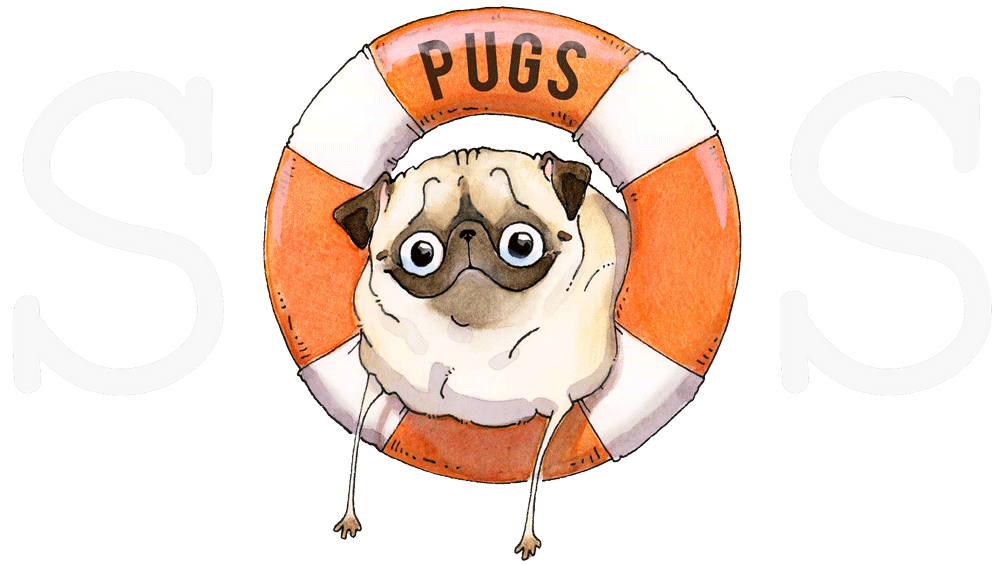Pug Information
Useful information on looking after the health and wellbeing of the Pug Enquiry FormDonatePug Information Library
The Pros and Cons of owning a Pug
It is our belief that every website you view will have gorgeous photos of pug puppies at play, adults winning in the show ring, and enjoying life as a healthy individual. This is, of course, all possible - providing certain criteria are met.
Personally we do not believe pugs suit full time working couples or hot climates.
Eye Issues
In Australia we have very hot summers, with high winds resulting in dry conditions, dust, and unrelenting heat. Pugs face an uphill battle as soon as summer starts. They have large protruding eyes that can dry out within a couple of hours. Because the eye surface is so large, it gets dust and debris stuck on the surface - resulting in scratches and painful ulcers very easily. Pugs eyes are very vulnerable when playing with active dogs, and can get scratched easily by claws, branches or sharp objects.
Overheating Issues
They have a thick, double coat (short hairs close to the skin and long guard hairs) that is present all year round (it does not fall out in summer to help them cool off). This thick coat sheds all year round - which can make many owners want to leave their pug outside as it is too messy inside.
They have a short face with a very wide throat area - it can be so wide at times that the roof at the back of the mouth 'collapses', making it extremely difficult to take in air and cool off.
Separation Anxiety Issues
Pugs were bred in China to be companion dogs. Just like border collies and kelpies are bred to round up sheep and cattle ... pugs were bred with just as strong a 'working' drive to be with people all day. It would be unkind to purchase a border collie if you lived in an apartment and did not give it sufficient exercise, it would be almost cruel to purchase a pug if you have to go to work and leave it unattended for 6 to 8 hours per day on its own.
Suggested Options
We do understand that people love pugs, and would like to own one. We also understand that people have to work - however we strongly recommend that you either wait until you are home more, or that you leave your pug with parents or family, or even a doggy daycare if you have to leave him or her for more than 4 hours per day..... or buy TWO PUGS!
A pug will settle much more and be more content if they have a friend at all times - there are a couple of options ... ask the breeder to consider reducing their rate so that you can buy two puppies at the same time. It is much better to buy two at the same time (rather than a year apart) as they then have company instantly (why wait 12 months?), are the same size (the larger one will not injure a younger, smaller one during rough play), they have the same energy levels (will fall asleep at the same time ... rather than a tiny baby sleeping for large parts of the day, and the older one still awake and restless).
If you really do love pugs - then you would be the sort of owner that would want the very best for them - which means not purchasing a pug that you have to leave for 8 hours per day on his own.
If you are house proud and dislike dog hairs everywhere, or if you have to work long hours, or if you simply think dogs should live outside - we urge you to reconsider your choice of dog and not choose a pug in this instance.
Below we have outlined some common pug eye issues, throat issues and skin issues. Unfortunately eye issues are common and frequent. Animal Eye Care have kindly provided just a few of the more common eye conditions that they see week-in, week-out. We have detailed the problem and costs involved with each photo. We have also outlined throat problems and skin problems.
For a list of Canine Eye Specialists please via state below.
NSW
Eye Clinic for Animals
Crows Nest NSW
02 9436 4884
Small Animal Specialist Hospital (SASH)
North Ryde NSW
02 9889 0289
Open 24 hours
SA
Veterinary Ophthalmic Referrals
Plympton SA
08 7324 2810
WA
Perth Animal Eye Hospital
Manning WA
08 6110 1616
Eye Issues

Overly large eyelids on this pug caused over exposure of the cornea (eye surface) resulting in chronic pigmentation and scarring. Scarring and pigmentation over the surface causes loss of vision.

This is the result of sewing the corner of the eye shut due to overly large eyelids, which had caused scarring to the cornea.

Corneal Perforations with Iris Prolapse
In this photo, the cornea has perforated, causing the inner eye gel to leak out. The iris (black lens in the centre of the eye) has actually plugged the hole in this instance. Cost of treatment: $1,500 to $2,000 + ongoing medication. A corneal perforation with iris prolapse can occur within 8 to 24 hours of an ulcer forming.
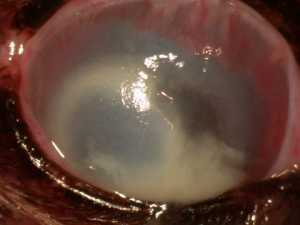
Infected Ulcer resulting in infected cornea
An ulcer on the surface eye will breach the protective and healthy cornea, and untreated, can quickly become infected. Once infected, the cornea starts to completely break down (melt). This photo shows a melting cornea.
Treatment: Full graft over the eye surface - approximately $900 for surgery, followed by $300 to remove the graft several months later. There is a likelihood that only 50% vision would be retained. The only other option for this eye would be removal.
Loss of Vision or Eye

Pigment spreading across the cornea
This will eventually lead to complete loss of vision if not treated. Genetically, pug suffer from 'dry eye' (a lack of tears coming through to lubricate the surface of the eye) and 'entropian' (ingrowing eyelashes, which rub painfully against the surface of the eye).
Both conditions cause ulcers and pigment scarring - painful conditions which left untreated will result in a loss of vision and/or loss of the eye.
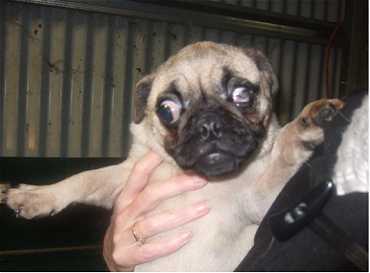
Puppy Farm Pug
This pug was found during an raid on a puppy farm. Her untreated ulcer resulted in a corneal perforation, and most of the eye content leaked out.
Her eye is now half the size of the other eye, and there is no vision. She would have been in a terrible amount of pain.
Outdoor Issues
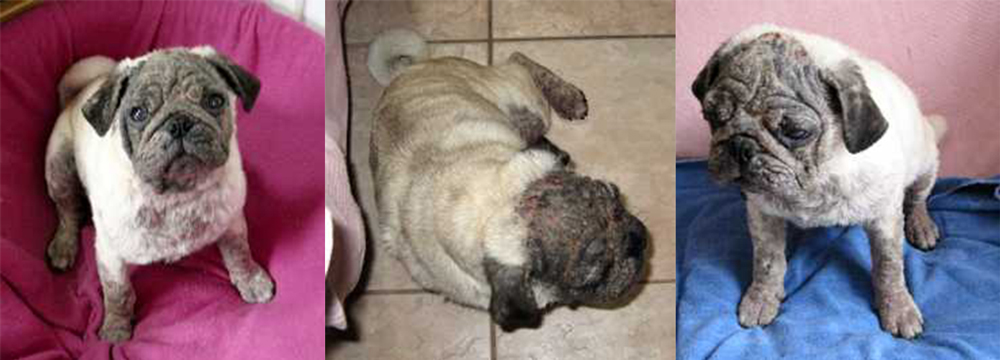
This Pug had a generic condition called Demodectic Mange.
Hot weather had caused his skin condition to spread rapidly.
Same Pug after many months of treatment!

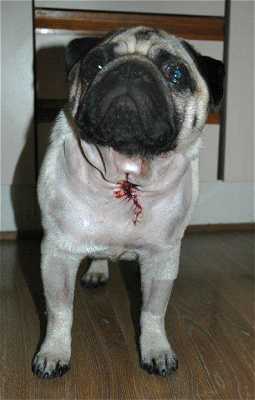
Breathing Issues
Apart from the fact that pugs snore loudly when asleep, they can have various other breathing problems. Here is Jackson, who had laryngeal collapse. He could no longer breathe, and had to have emergency surgery with Dr Charles Kuntz, and he now lives with a permanent tracheostomy.

If you feel that you can offer a pug a great home (living inside the house) If you are home most of the day or have family who can 'babysit' while you are at work, and you are realistic in your budgetting for vet bills) then of course we highly recommend pugs as fun loving, intelligent dogs that adore children, the family, food, playing, walks in the park or on the beach and sleeping as close to you on the bed as possible!
Eye Ulcers in Pugs (and other breeds)
Written in layman’s terms by Belinda Goyarts, Raevon Pugs
audited (with many thanks) by Dr Chloe Hardman BVSc, FACVf, Opthal , Animal Eye Clinic, Melbourne
Having owned pugs for a while now, I have become rather more acquainted with eye ulcers than I ever wanted to. Pugs are filled with enthusiasm, resulting in an extremely active and energetic breed of dog that just has to investigate every single thing in life. This is great however with a standard that calls for eyes to be dark, very large and globular in shape I sometimes wish that my beloved breed had more of a couch potato disposition. I also find that Australian conditions (hot, dry and dusty) are not conducive to owning pugs I’m quite sure UK Pug owners do not have as many day to day challenges!
Pugs, boxers (and other dogs prone to eye problems) seem to get ulcers from scratches (plants/sticks/playing with another dog), or a bit of soap in the eye from bathing, from lying beside a fan heater, a hot dusty day can result in the cornea (eye surface) drying out, dust, eye lashes rubbing on the surface, or in the case of my guys at times, it seems just breathing!
General practitioner veterinary clinics do a good job with eyes in most cases, however I have learned enormous amounts from the actual eye care specialists Animal Eye Care in Malvern and their treatments are extremely effective. This article is written so that owners can have a better understanding of eye ulcers and how to treat them immediately, thereby in a high percentage of cases fixing the problem in a couple of days, rather than weeks, or worse, losing an eye altogether.
First signs to watch for
The very first sign of an ulcer is generally excessive ‘blinking’ of the eye with some excess tears. If slightly worse, the eye can be squinting, and the lids look a little swollen. A trip to the vet and staining of the eye with a green dye will reveal the ulcer in its various stages.
The cornea (eye surface) is 0.7mm thick in the dog and has several layers the epithelium (surface) (7 cell layers thick), the stroma = collagen in about 100 layers (like an onion), the endothelium and Descemet’s membrane.
A very shallow ulcer (often just epithelial depth) can be barely visible, but may develop a bluish clouding over a portion of the eye from fluid retention (oedema) due to inflammation. Sometimes ulcers can look like a white pin prick, a white scratch, or even a larger white area as big as a flattened cotton tip bud. Deeper ulcers can look like a hole or a divet (these involve the stroma). Very deep ulcers look like a deep hole, and the inner membrane can bulge = Descemetocoele. These can perforate, resulting in a collapse of the eye.
You’ve ascertained that there is an ulcer now what?
The major, very serious problem with ulcers is that quite apart from being painful, they can get infected very very quickly, which is where the BIG problems start.
Treated superficial ulcers can sit on the eye surface and heal at a normal rate, the big issue is to clear them up quickly as the longer they sit there, the more chance they have of becoming infected and it is the infection that will rapidly eat through the surface layers of the cornea and result in perforation, quickly reaching the gelatinous filling of the eye – which can then leak out of the ulcerated hole. You have then progressed from a fairly easy-to-fix problem to a major issue involving surgery, grafts and/or possible loss of the eye.
Initial treatment
- Confirmation of the ulcer through staining with a Fluorescein strip. It is a good idea to have a look yourself once the ulcer is outlined clearly through the staining by the veterinarian, so that you can note if it is getting smaller/bigger after a day or two when you are at home.
- Immediate prescription of antibiotics and anti-inflammatory drugs for pain relief/prevention of infection.
It is imperative that antibiotics be given in two forms:
- Tricin antibiotic cream: This is an antibiotic ointment that is administered 3 x daily to the eye. Tricin eye cream is excellent as it lubricates the surface and is broad spectrum, however it only stays in the eye a short period of time as is washed away by tears. For this reason, it is essential that another form of antibiotic be administered that will have a longer and more lasting effect against possible infection:
- Vibravet (doxycycline) tablets (oral antibiotics)
The Vibravet tablets are the best form of antibiotics to use in eye injuries as they concentrate in the dog’s tears, and flush over the eye 24 hours a day. Just as importantly, it has recently been found that Vibravet, apart from fighting infection, promotes the healing of the cornea AND is anti inflammatory. Worth its weight in gold!
Anti-inflammatory drugs
- Rimadyl (or similar) tablets should be prescribed – they are an anti-inflammatory and also offer effective pain relief
- Optimmune ointment 3 x daily – which acts like false tears and lubricates and protects the eye, has anti-inflammatory properties, and promotes normal tear production/healthy tear film.
If corneal ulcers become infected, or resist healing, more potent antibiotics should be used. e.g. fortified gentamicin drops (gentamicin ointment and drops not strengthened by adding extra gentamicin drug are of little use). These drops need to be used 10+ times daily initially until the infection has resolved (may take 7 days +).
- An alternative is Ocuflox (ofloxacin) that is even more potent.
On arriving home
When you arrive home, put on an Elizabethan collar (to prevent him rubbing his eye) and keep inside out of the wind and dust, until blinking and inflammation has disappeared. Gently wipe any mucous away from the eye with sterile (or boiled) water before applying creams. DO NOT RUB CREAMS INTO THE EYE as you risk causing further trauma to the site. Apply the cream from approximately 1 cm away, and it will dissolve over the corneal surface. With smaller ulcers that have not become infected, you should notice a change within 24 hours, and an almost clear corneal surface within 3 days.
The ulcer is not healing
Sometimes the position of the ulcer is so central, or so minimal in size, that blood vessels are not reaching out far enough to heal it. This is what you would then call an ‘indolent’ ulcer – meaning that although it is not necessarily getting bigger – it is not healing either. The danger lies in that the longer the ulcer is present, the greater the chance of infection occurring – so it needs to be dealt with quickly and effectively.
To encourage healing – vets can put anaesthetic drops on the eyeball and then lightly debride (rub) the surface of the ulcer with a cotton tip bud to remove any unhealthy tissue that was not properly attached to the cornea (due to the presence of the ulcer). This loose tissue can have a delaying or negative affect in healing.
However, if the vet debrides the ulcer and its edges peel back – surgery is generally needed in the form of a grid keratotomy.
Grid Keratotomy
This is only done to VERY SUPERFICIAL ulcers, and needs to be performed under a general anaesthetic. Eye specialists may be able to perform this with the patient awake under a topical anaesthetic in the consult room depending on how large the ulcer becomes when the edges are peeled off and the unhealthy epithelium (skin layer) is removed.
A grid keratotomy involves taking a fine hypodermic needle and etching grid lines on the surface of the cornea over and around the ulcer. The grid lines allow healthy cells surrounding the ulcer to move along the channels into the unhealthy section of the cornea, thereby promoting healing.
To protect the site, the third eyelid can then be raised and attached to the upper eyelid with stitches. In some cases, the inside of the third eyelid can be scarified (shallow cuts/scraping performed) to allow the resulting blood flow directly on to the cornea to stimulate healing. The raising of the third eyelid will promote healing, and protect the eye from further trauma.
In the case of a deep hole/ulcer
Deep holes/ulcers require a conjunctival pedicle graft surgery will lift up an area of healthy conjunctiva (eye surface) and graft it over the unhealthy area. This is sewn into the ulcer bed. To protect the eye, a temporary tarsorrhaphy is done (a couple of stitches closing the upper and lower eyelid at the outer/inner corner closest to the graft site). These stitches are removed once the graft has reduced in size and the eye is returning to its more normal state.
Greater eye traumas signs to watch for
Initial symptoms of an ulcer can be blinking and excess tears. It is easy to keep an eye on this on a daily basis. After surgery has been done however, and the eye itself is covered by the third eyelid flap, it is not as easy to keep an eye on progress.
Initial symptoms of problems/greater eye injuries: inflamed eye area, redness, swelling, the dog averting its head from light, pulling its head away from the eye area as if trying to escape pain, sleeping a lot (an excellent sign to watch for when the third eye lid is sewn up – the dog gets so tired from the pain that it actually sleeps far more than normal).
Another excellent pain indicator is to compare pupils (if you do not have a third eyelid flap raised). The normal healthy eye will have a pupil that contracts with light, and dilates back again when you remove the direct light. An eye in distress will generally have a pin prick pupil – as the eye spasms in pain and prevents the pupil from dilating.
In spasming pinprick cases, vets will administer Atropine hourly for a few hours to relieve the spasms (on top of all the other treatments). Atropine causes the pupil to dilate to its fullest for 24 hours or more, making the eye extremely sensitive to light (as it cannot contract) so it is most important that when Atropine is being administered, you keep you dog in the darkened room.
Theories/alternative remedies
I have discussed at length with the Animal Eye Care team the alternative remedies used by owners – several that come to mind immediately:
Breeders have at times praised the use of milk, cod liver oil and/or serum taken from the affected dog as a treatment for ulcers. Whilst Animal Eye Care did not discount these remedies – they did make a good point – which is that ulcers easily and rapidly become infected – which means they MUST be treated with antibiotics. Cod liver oil and serum may help with healing – but only after the danger of infection has been removed.
Emergency Eye Kit
Living and travelling with Pugs means having emergency eye kits situated in various places. I always have one in the car, the show trailer, the caravan and in the house. I am not in any way advising readers not to seek veterinary advice, however I have found that if I am at a dog show, and miles away from my vet on a public holiday, I can at least commence treatment, which has no adverse affect on my dogs and will provide pain relief and possible prevention of infection. My emergency kits are made up of:
- Fluorescein staining strips
- Rimadyl tablets (pain relief and anti-inflammatory)
- Vibravet (antibiotics)
- Tricin ointment (antibiotics)
- Optimumme (lubrication and and anti-flammatory)
- Sterile water sachets (x 2) for debris removal
- Cotton pads (non fibrous)
- Atropine drops – these drops are an extremely important part of your eye kit. They dilate the pupil and have two functions. 1) They stop the eye spasming in pain and 2) in the cases of a deep ulcer which is looking like it is on its way to perforating during your drive to the vet the atropine drops have caused the pupil to dilate which in turn can potentially plug the hole caused by perforation, and prevent too much loss of pressure before you get to the veterinarian
I keep all these items in each kit, and have found the small flatish Tupperware containers to be excellent as they store in small places easily, such as the car console.
This article only covers some of the more common occurrences that can crop up on a daily basis and is just information that I have accumulated over the years and hopefully can be of some use. It has been checked by Dr Chloe Hardman at Animal Eye Care for accuracy.
Belinda Goyarts
www.raevonpugs.com
www.morningtonlodge.com.au
Australian Eye Specialists
NSW
Eye Clinic for Animals
Cameron Whittaker and Jeff Smith
64 Atchison Street, Crows Nest, NSW 2065
02 9436 4884
Sash Vets
Mark Billson
Level one, 1 Richardson place, North Ryde, Sydney, NSW 2133
02 9889 0289
QLD
Brisbane Veterinary Specialist Centre
Anna Deykin and Edith Hampson
Corner of Northern and Keong Roads, Albany Creek, QLD 4035
07 3264 9400
Animal Eye Services
Mike Bernays
Shop 14 Hometown, Underwood, QLD 4119
07 3341 1981
SA
Adelaide Veterinary Specialist and Referral Centre
Tony Read
102 Magill Road, Norwood, SA 5067
08 8132 0533
WA
Rivergum Referral Services
Martyn King
1/26 Gympie way, Willetton, WA 6155
08 9259 6344
VIC
Animal Eye Care Centre
181 Darling Road, East Malvern, VIC 3145
03 9563 6488
Vets who spey/neuter at 10 weeks
Yarraville
Yarrraville Vet Surgery (Dr Rosie Jordan)
291 Williamstown Rd, Yarraville 9314 8945
Animal Hospital Yarraville
110 Stephen St Yarraville 9689 8100
Sedden
Seddon Vet Hospital
146 Victoria St Seddon 9689 9333
Caroline Springs
Caroline Springs Veterinary Hospital
225-227 Caroline Springs Boulevard Caroline Springs 8390 2266
Newport
Hobsons Bay Veterinary Clinic
318 Melbourne Road Newport 9391 4222
Croydon
Maroondah Vet Clinic
30 Maroondah Hwy Croydon 9870 0303
Mornington
East Mornington Veterinary Clinic
Tyabb Road, Mornington (as well as their clinics in Rye and Dromana) 5975 7766
Ballarat
Ballarat Vet Practice (Richard Lawrence)
03 5331 1533
Bendigo
McIvor Rd Vet Clinic (Sue Collins) (male puppies 8 weeks females 10 weeks)
03 54437749
Altona North
Altona North Veterinary Clinic (Dr Cameron)
221 Miller St Altona North 9391 5837
Footscray
Footscray West Veterinary Clinic 9687 4542
St Albans
St Albans Veterinary Clinic
263 Main Road West St Albans 9 364 3777
South Australia
Noahs Crossing Veterinary Clinic (Dr Chris Gurling)
Lewiston SA 08 8524 2260
Western Australia
Vitalvet (Dr B. Odesnik)
Unit 1A, 40 Coolamon Boulevard Ellenbrook
WA 08 6296 7711

